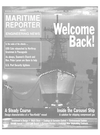
Page 8: of Maritime Reporter Magazine (October 2001)
Read this page in Pdf, Flash or Html5 edition of October 2001 Maritime Reporter Magazine
Investment in Design
Now the Carousel Ship by David Tinsley, technical editor
Technical proposals for the shipment of natural gas under compression rather than in the refrigerated, liquefied state have surfaced from time to time over the years, but have received a lukewarm response from the marine industry. The considerable cost of the shipboard containment methodology has been a major stumbling block. Now, a Canadian engineering contractor has come up with an altogether more economic solution to the cargo carry- ing needs of compressed natural gas (CNG), and pitched at relatively short-distance sea transport appli- cations.
Instead of the prohibitively expensive pressure bot- tles that have earlier been central to CNG transport concepts, Cran & Stenning Technology has proposed a more efficient and economical pressure vessel made from small-diameter pipe coiled into a steel carousel. The CNG ship would be equipped with multiple carousel units, stacked below decks in inerted holds.
Each Coselle (coil in a carousel) gas storage unit con- tains 10 miles of 6-in. diameter pipe, wound within compact external dimensions of 50-ft. diameter and 11 -ft. depth. The standard Coselle CNG carrier would be fitted with 108 coselles, giving a cargo capacity of 7,700-tons or 330-million cu. ft. The configuration would keep the newbuild cost to less than 40 percent of that of an equivalent CNG 'bottle' ship, it is claimed, since the Coselles are much cheaper to pro- duce than pressure bottles, yet offer an equivalent level of safety.
While the cargo volume pales against the 60,000-tons or so accommodated in a deep-sea LNG carrier, the lat- ter requires a substantial infrastructure, including cryo- genic facilities for liquefying the gas for transport, cou- pled with large reserves and large, sustained shipment volume demand.
The modest load intake of the Coselle CNG ship is pertinent to its target markets, including offshore or small reserves, and small or developing markets, in which the LNG carrier mode is generally economical- ly unattractive. The technology holds out the prospect of commercially exploiting small or marginal gas fields, akin to the way in which floating production, storage and offloading (FPSO) vessels have enabled a broader spread of oil reserves to be economically tapped.
For projects involving smaller volumes and shorter distances, an articulated tug-barge (ATB) unit has also been developed, with a shipment capacity for 80-mil- lion cu. ft. of gas in 28 Coselles. Cran & Stenning are hoping to give form to the concept before too long, in the shape of a pilot shipment scheme involving a tug- barge combination. The Canadian firm has the world- wide right to use and license the proprietary, patented
Coselle CNG technology.
THE PROVEN LEADER IN
TRACTOR TUG APPLICATIONS
The advent of tractor tugs permanently changed the industry by offering unparalleled maneuverability and power. The key to harnessing the tug's potential was the ^H development of an ultra high-strength, lightweight ship assist line. Samson Rope Technologies met this challenge with the development of AmSteel®-Blue and today it is still the! industry standard aboard tractor tugs.
AmSteel®-Blue is an excellent example of Samson's ability to translate new fiber technologies into working solutions for tug and marine applications. It is just one more reason Samson is the strongest name in rope.
TIE-UP WITH SAMSON
Made with JJJ/jlS^JjJlJ DSM's registered trademark for High Performance Polyethylene Fiber.
The Strongest Name In Rope 2090 Thornton Street, Ferndale, WA 98248 {T} 800.227-7673 / 360.384.4669 (F) 800.299.9246 / 360.384.0572
Circle 309 on Reader Service Card or visit www.maritimereporteririfo.com
Maritime Reporter & Engineering News

 7
7

 9
9
